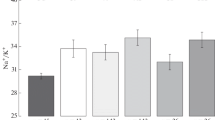Summary
Experiments were carried out in Wistar rats to determine whether the loss of sensitivity of the tubuloglomerular feedback mechanism (TGF) which is known to occur in volume expansion is due to a change in the functional characteristics of the juxtaglomerular apparatus or to a change in some property of the tubular fluid which influences the feedback signal at the macula densa. Proximal tubular fluid was collected by means of a microperfusion/suction pump from Wistar rats maintained for a minimum of 10 days on a high salt diet and also from rats fed a control low salt diet. Both fluids were then used to perfuse loops of Henle in rats from both groups and the feedback response assessed from the change in early proximal tubular flow rate (EPF). In high salt rats, perfusion of the loop of Henle with homologous tubular fluid confirmed the loss of sensitivity of the TGF mechanism in volume expansion, the response of EPF was practically absent. In contrast, the low salt rat responded with a 50% decrease in EPF to loop perfusion at 40 nl/min with its homologous fluid. On the other hand, when the loop of Henle in high salt rats was perfused at 40 nl/min with heterologous (low salt) tubular fluid, EPF again decreased by some 50% whereas EPF in low salt rats failed to respond to loop perfusion with high salt fluid. From these results it is concluded that in rats chronically volume expanded by a high salt diet an unknown inhibitory principle occurs in the proximal tubular fluid which reduces the sensitivity of the tubuloglomerular feedback mechanism.
Zusammenfassung
Bei normalem Extrazellulärvolumen reduziert der Harnfluß durch das macula densa Segment der Henle'schen Schleife die glomeruläre Filtrationsrate durch ein Signal aus dem juxtaglomerulären Apparat (tubuloglomerulärer Rückkopplungsmechanismus, TGF). Bei Vergrößerung des Extrazellulärvolumens wird dieser Mechanismus gehemmt, so daß die glomeruläre Filtrationsrate ansteigt. Um festzustellen, ob diese Hemmung durch Veränderungen im juxtaglomerulären Apparat oder in der Tubulusflüssigkeit verursacht wird, wurden an zwei Gruppen von Ratten, deren Extrazellulärvolumen entweder normal war oder durch kochsalzreiche Ernährung expandiert wurde, Austauschversuche mit spätproximaler Tubulusflüssigkeit durchgeführt. Die Tubulusflüssigkeit wurde mit Mikrosaug/Perfusionspumpen gesammelt. Ihre Wirkung auf den TGF wurde geschätzt, indem Henle'sche Schleifen einzelner Tubuli mit 40, 10, und 0 nl/min perfundiert wurden, während gleichzeitig der Harnfluß (EPF) in einem glomerulusnahen Segment des jeweiligen proximalen Tubulus gemessen wurde. Insalzreich ernährten Tieren war die EPF von der Schleifenperfusionsrate unabhängig, wenn die Henle'schen Schleifen mithomologer Tubulusflüssigkeit perfundiert wurden. Mit Tubulusflüssigkeit aussalzarm ernährten Tieren und einer Schleifenperfusionsrate von 40 nl/min fiel die EPF jedoch um etwa 50% gegenüber dem Kontrollwert bei nichtperfundierter Schleife ab. Insalzarm ernährten Tieren, deren Henle'sche Schleifen mithomologer Tubulusflüssigkeit und einer Rate von 40 nl/min perfundiert wurden, fiel die EPF um etwa 50% gegenüber dem Kontrollwert bei nicht perfundierter Schleife ab. Mit Tubulusflüssigkeit aussalzreich ernährten Tieren war die EPF von der Schleifenperfusionsrate unabhängig. Es wird gefolgert, daß der TGF in volumenexpandierten Tieren durch eine Substanz in der Tubulusflüssigkeit gehemmt wird.
Similar content being viewed by others
References
Dev B, Drescher C, Schnermann J (1974) Resetting of tubuloglomerular feedback sensitivity by dietary salt intake. Pflügers Arch 346:263–277
Häberle DA, Davis JM (1982) The interrelationship between proximal tubular hydrodynamics and tubuloglomerular feedback in the rat kidney. Kidney Int (in press)
Häberle DA, Shügai R (1979) Flow dependent reabsorption of tubular fluid in chronically salt deprived and salt loaded rats. Pflügers Arch 379:R16
Häberle DA, Shiigai TT, Mayer G, Schiffl H, Davis JM (1981) Dependency of proximal tubular fluid transport on the load of glomerular filtrate. Kidney Int 20:18–28
Mason J, Moore LC (1982) A new way of investigating tubuloglomerular feedback. The closed loop model. Kidney Int (in press)
Moore LC, Yarimizu S, Schubert G, Weber PC, Schnerman J (1980) Dynamics of tubuloglomerular feedback adaptation to acute and chronic changes in body fluid volume. Pflügers Arch 387:39–45
Schnermann J, Davis JM, Wunderlich P, Levine DZ, Horster M (1974) Technical problems in the micropuncture determination of nephron filtration rate and their functional implications. Pflügers Arch 329:307–320
Schnermann J, Ploth DW, Hermle M (1976) Activation of tubuloglomerular feedback by chloride transport. Pflügers Arch 362:229–240
Schnermann J, Schubert G, Hermle M, Herbst R, Stowe NT, Yarimizu S, Weber PC (1979) The effect of inhibition of prostaglandin synthesis on tubuloglomerular feedback in the rat kidney. Pflügers Arch 379:269–279
Thurau K, Schnermann J (1965) Die Natriumkonzentration an den Macula densa-Zellen als regulierender Faktor für das Glomerulumfiltrat. Klin Wochenschr 43:410–413
Author information
Authors and Affiliations
Rights and permissions
About this article
Cite this article
Häberle, D.A., Davis, J.M. Chronic salt loading: Effects on plasma volume and regulation of glomerular filtration rate in Wistar rats. Klin Wochenschr 60, 1245–1248 (1982). https://doi.org/10.1007/BF01716731
Issue Date:
DOI: https://doi.org/10.1007/BF01716731
Key words
- Chronic salt loading
- Volume expansion
- Glomerular filtration rate
- Tubuloglomerular feedback
- Humoral substances in tubular fluid



